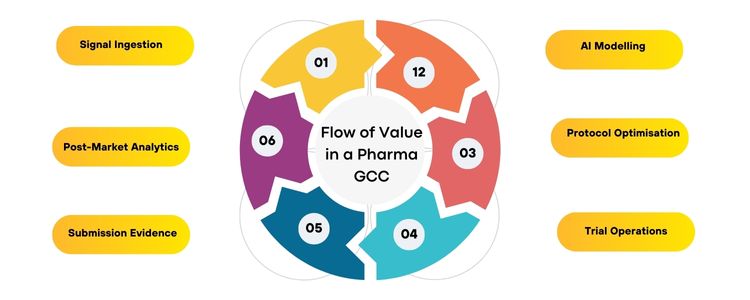
Pharma GCCs are no longer making their mark only based on cost savings but rather on discovery acceleration. India is home to ~1,900 GCCs globally (~53% of the total), with ~3,200 in existence worldwide, and is rapidly growing in scale and capabilities based on the requirements of AI and R&D. The macro tailwinds are quite strong in pharmaceuticals. The current Indian pharmaceutical industry is estimated at ~US$55-65B, supports around 20 per cent of global generics and 60 per cent of low-cost vaccines, and is forecasted to reach US$120-130B by 2030. This is a growth chart that enhances global access even if it increases the Indian export surplus. This creates India as a pharma innovation hub for pharma multinationals to build discovery in GCC playfields that compress R&D cycles and reduce the overall cost of discovery.
In July 2025, Eisai announced a Global Capability Center in Visakhapatnam, with a vision to be a digital nerve center of AI-enabled drug development, clinical data analytics, and decision support that would support its human healthcare mission in India. It turns out to be a blueprint that pharma leaders can follow by putting patient-centric digital R&D within reach of deep data, maths and engineering at scale.
Each step draws advantage of India’s cost-effective skilled units, standard platforms and 24X7 execution, closing the loop between visibility and action.
The economic benefits are gained along three axes: The cumulative impact is reduced cycle time, improved R&D throughput and superior global access economics – important factors in making India a pharma innovation hub.
Vizag GCC will highlight the next generation of the GCC pharmaceutical market: AI-first clinical data engines, precision medicine analytics and university/start-up co-innovation with India as a hub. The message to the pharma leaders is straightforward: have your core digital drug development in India; it is going to be faster, smarter, and more human-centred.
The GCC strategy by Eisai in India is proof of how pharmaceutical companies can move beyond the conventional outsourcing models and build innovation centers. India has the scientific prowess, low-cost advantage and a fast-developing GCC ecosystem, which gives the country an advantage in being a leader in healthcare innovation. The consequence for global pharma is that by opening GCCs in India, it can gain efficiencies through faster discovery, lower costs and scalable patient-centric solutions – transforming India into the key to the future of the GCC pharmaceutical market.
Inductus GCC services unlock the future of pharmaceutical innovation. We help global pharmaceutical players to grow big in India by designing compliant and AI-enabled centers, developing world-class talent and governance structures and much more. Be our partner to make your GCC a hub of healthcare innovation and influence in the world.
A GDC refers to a single-minded offshore deployment, which provides proficient business, technology and operational services to corporate bodies on a global basis. BFSI, IT services, healthcare, telecom, retail, manufacturing, and other upcoming technologies, including AI and blockchain. They do not only target cost savings but now aim at innovation, automation, R&D, digital transformation, and high-value consulting. They design and create cloud, artificial intelligence, analytics, cloud security, and process automation. A large supply of STEM graduates, multilingual workers and niche skills in AI, ML, cloud, and analytics. Aditi, with a strong background in forensic science and biotechnology, brings an innovative scientific perspective to her work. Her expertise spans research, analytics, and strategic advisory in consulting and GCC environments. She has published numerous research papers and articles. A versatile writer in both technical and creative domains, Aditi excels at translating complex subjects into compelling insights. Which she aligns seamlessly with consulting, advisory domain, and GCC operations. Her ability to bridge science, business, and storytelling positions her as a strategic thinker who can drive data-informed decision-making.
Eisai Bets on India GCC
India For Healthcare Innovation
Eisai’s GCC strategy
Pillar (What We Build/Operate)
What It Enables
Business Impact
Patient-centric data platforms
Integrate RWD/RWE, eSource pipelines, and quality signals.
Faster evidence generation; risk-based monitoring
AI for discovery & development
ML for molecule triage, safety signal detection
Reduced pre-clinical & clinical cycle time
Cross-border collaboration fabric
Real-time Japan–US–India workflows, compliant data exchange
Fewer handoffs; higher trial velocity
Talent pipelines & governance
Clinical data science, biostats, MLOps, GxP controls
Scale with compliance, lower total cost
Global Patient Outcomes Innovation Hub India

Some Data Points That De-Risk the Model
Economic Benefits
Our BOT Strategy For Pharma GCC
What’s Next?
Conclusion
frequently asked questions (FAQs)

Aditi
Hey, like this? Why not share it with a buddy?
Related Posts
Recent Blog / Post
- Agile Methodologies for GCCs: A Blueprint for Success October 6, 2025
- The Legal and Compliance Checklist for a New GCC Setup October 4, 2025
- The Rise of Niche GCCs: A Focus on Specialised Capabilities October 4, 2025
- The Impact of Regulatory Changes on GCC Operations October 4, 2025
- Cybersecurity for GCCs: A Proactive Approach to Data Protection September 30, 2025
- Beyond Cost: Measuring the True ROI of Your GCC Investment September 29, 2025
- The Future of GCCs in the Retail Sector: A Strategic Playbook September 29, 2025
- David vs Goliath: Mid-Sized GCCs Quietly Outperform the Big Brands September 29, 2025
- Infineon’s Big Bet on India: Inside Its First GCC in GIFT City September 29, 2025
- From Campuses to Capability Centres: How Indian Universities Power the Global GCC Ecosystem September 29, 2025
- Retail Meets Digital: Costco’s GCC in Hyderabad Marks a Global Shift September 29, 2025
- The Silent Crisis: Why Many GCCs Plateau After 3 Years and How to Avoid It September 24, 2025
- Germany’s New Skilled Immigration Act and Its Ripple Effect on the GCC Talent Model September 24, 2025
- From Tokyo to Hyderabad: The Future of GCCs for Japanese Conglomerates September 23, 2025
- GCCs as AI Acceleration Hubs: Collaborating with US and Nordic Tech Majors September 19, 2025
















